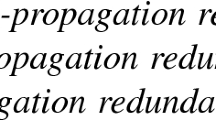Abstract
Many propositional calculus problems — for example the Ramsey or the pigeon-hole problems — can quite naturally be represented by a small set of first-order logical clauses which becomes a very large set of propositional clauses when we substitute the variables by the constants of the domainD. In many cases the set of clauses contains several symmetries, i.e. the set of clauses remains invariant under certain permutations of variable names. We show how we can shorten the proof of such problems. We first present an algorithm which detects the symmetries and then we explain how the symmetries are introduced and used in the following methods: SLRI, Davis and Putnam and semantic evaluation. Symmetries have been used to obtain results on many known problems, such as the pigeonhole, Schur's lemma, Ramsey's, the eight queen, etc. The most interesting one is that we have been able to prove for the first time the unsatisfiability of Ramsey's problem (17 vertices and three colors) which has been the subject of much research.
Similar content being viewed by others
Explore related subjects
Discover the latest articles, news and stories from top researchers in related subjects.References
Bauer, M., Brand, D., Fischer, M. J., Meyer, A. R., and Paterson, M. S., ‘A note on disjunctive form tautologies’,SIGACT News 5, 17–20 (1973).
Benhamou, B. and Sais, L., ‘Etude des symétries en calcul propositionnel’, Rapport de recherche Maiup No. 91-01, Université de Provence (1991).
Benhamou, B. and Sais, L., ‘Etude des symétries en calcul propositionnel’, Mémoire de Dea GIA-Marseille-Luminy (France) (1990).
Cubbada, C. and Mouseigne, M. D., ‘Variantes de l'algorithme de sl-resolution avec retenue d'information’, Thèse de 3ème cycle. GIA, Marseille, Luminy (France) (1988).
Davis and Putnam, ‘A computing procedure for quantification theory’,JACM 7 201–215 (1960).
Krishnamurty, B. and Moll, R. N., ‘Examples of hard tautologies in the propositional calculus’,Proc. Thirteenth ACM Symp. Th. of Computing, pp. 28–37 (1981).
Krishnamurty, B., ‘Short proofs for tricky formulas’,Acta Informatica 22 253–275 (1985).
Kowalski, R.A. and Kuehner, D., ‘Linear resolution with selection function’,Artificial Intelligence 2 227–260 (1971).
Lyndon, R. C.,Notes on Logic, Van Nostrand Mathematical Studies (1964).
Oxusoff, L. and Rauzy, A., ‘L'evaluation semantique en calcul propositionnel’, Thèse de 3ème cycle, GIA, Marseille, Luminy (France) (1989).
Siegel, P., ‘Representation et utilisation de la connaissance en calcul propositionnel’, Thèse d'etat, GIA, Marseille, Luminy (France) (1987).
Tseitin, G. S., ‘On the complexity of derivation in propositional calculus’, In:Structures in Constructive Mathematics and Mathematical Logic, H. A. O. Shsenko (Ed.), pp. 115–125 (1968).
Bibel, W., ‘Short proofs of the pigeonhole formulas based on the connection method’,J. Automated Reasoning 6 287–297 (1990).
Kalbfleisch, J. G. and Stanton, R. G., ‘On the maximal triangle-free edge-chromatic graphs in three colors’,J. Combinatorial Theory 5 9–20 (1969).
Cook, S. A., ‘A short proof of the pigeonhole principle using extended resolution’,SIGACT News 8 28–32 (1976).
Author information
Authors and Affiliations
Rights and permissions
About this article
Cite this article
Benhamou, B., Sais, L. Tractability through symmetries in propositional calculus. J Autom Reasoning 12, 89–102 (1994). https://doi.org/10.1007/BF00881844
Received:
Accepted:
Issue Date:
DOI: https://doi.org/10.1007/BF00881844




